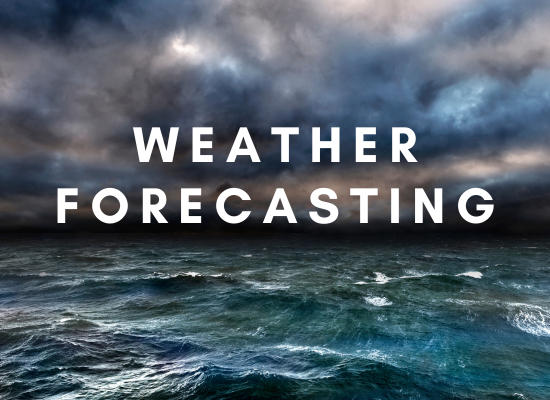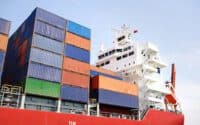Minimizing Loss Through Advanced Weather Forecasting

As ship owners seek to optimize their operations and drive profitability, advanced weather forecasting techniques stand out as key tools. These technologies not only safeguard voyages but also enhance efficiency and cut operational costs. Here, we delve into how predictive analytics for route optimization and dynamic routing directly impact shipping operations.
* Please send feedback/suggestions to editor @ shipuniverse.com
Predictive Analytics for Route Optimization
Modern shipping relies heavily on predictive analytics, which uses historical data, real-time updates, and advanced modeling to forecast weather conditions. This forecasting enables operators to make informed decisions about the safest and most efficient routes for their vessels.
Dynamic Routing: One of the most critical applications of predictive analytics in maritime operations is dynamic routing. This technique involves continuously adjusting a ship’s course in response to new weather data and forecasts. By avoiding adverse weather conditions such as storms or high waves, ships maintain higher speeds and consume less fuel. Moreover, dynamic routing minimizes the wear and tear on the vessel, reducing maintenance costs and extending the ship’s service life.
The benefits are clear: ships reach their destinations more quickly and with lower fuel consumption, leading to significant cost savings and less environmental impact. Efficient routing also means that ships can take on more voyages over the same period, directly boosting revenue potential.
Reducing Idle Time with Precise Weather Predictions
In maritime logistics, time is a critical factor, and inefficiencies at any stage of the journey can cascade, leading to increased costs and operational delays. One of the most notable areas where time can be lost is during the docking and undocking processes at ports. Here, precise weather predictions play a pivotal role in enhancing port operation efficiency.
Port Operation Efficiency
Minimizing Waiting Times: The ability to accurately predict weather conditions is crucial for reducing idle time at ports. Shipping companies that utilize advanced weather forecasting can plan their arrivals and departures around optimal weather windows. This proactive approach prevents ships from arriving during adverse weather conditions, which can delay docking processes and lead to significant demurrage costs.
For example, if a storm is predicted to hit a port at a certain time, ships can adjust their speed en route or reroute to alternate ports if necessary. This flexibility not only helps in avoiding unsafe docking conditions but also ensures that ports are clear of congestion, which can further delay operations.
Decreasing Demurrage Costs: Demurrage costs — fees incurred when cargo vessels remain in port beyond their allotted time — can quickly add up and impact a company’s bottom line. By using precise weather forecasts, ships can schedule their port activities during periods of favorable weather, thereby reducing the likelihood of incurring these fees. Efficient scheduling also helps ports manage their space and resources better, leading to improved overall throughput.
Moreover, the predictability afforded by advanced weather forecasting helps in better resource allocation. Port authorities can plan and allocate dock workers, pilotage, tugs, and other essential services more efficiently, reducing the turnaround time for ships. This streamlined process not only saves money but also increases the port’s capacity to handle more traffic, which is beneficial for both port operators and shipping companies.
Minimizing Weather-Related Disruptions
Weather-related disruptions can pose significant challenges to maritime operations, affecting not only the timing but also the safety and financial aspects of shipping. Advanced weather forecasting tools play a critical role in minimizing these disruptions through effective contingency planning and risk mitigation.
Operational Continuity
Better Contingency Planning: Advanced forecasts allow shipping companies to prepare for adverse weather well in advance, enabling them to maintain operational continuity even in less-than-ideal conditions. This might involve rerouting ships to avoid storms, adjusting schedules to wait out bad weather, or speeding up operations to beat an incoming weather system.
The key here is the ability to integrate real-time weather data with predictive analytics, which helps in formulating various scenario-based strategies. This approach ensures that operations can continue smoothly with minimal disruptions, thereby keeping the shipping schedule on track. For instance, if a forecast predicts rough seas along a popular shipping route, companies can reroute their vessels through calmer waters, albeit possibly taking a bit longer but avoiding the risk of severe delays or damage.
Insurance Claims Reduction
Mitigating Risks and Lowering Insurance Claims: The direct correlation between proactive weather management and reduced insurance claims cannot be overstated. By avoiding areas with high weather risks, companies not only protect their assets but also significantly lower the likelihood of incidents that could lead to costly insurance claims. This prudent management is often recognized by insurance providers, who may offer lower premiums to companies that consistently demonstrate effective risk mitigation strategies.
Moreover, using advanced forecasting to minimize damage to cargo and vessels directly impacts a company’s claims history. A lower incidence of claims can lead to improved insurance terms and decreased costs over time. This is particularly valuable in the maritime industry, where the costs associated with weather-related damage can be substantial.
Potential Reduction in Premiums: Insurers are increasingly taking note of the tools and strategies companies employ to prevent losses. Those that leverage advanced weather forecasting technologies effectively often benefit from lower premiums due to their reduced risk profile. This creates a positive feedback loop, where cost savings from lower premiums can be reinvested into further improving operational efficiency and safety measures.
Cost Management through Enhanced Weather Forecasting
Efficient cost management is critical for maritime companies striving to enhance their profit margins and operational efficiencies. Enhanced weather forecasting plays a pivotal role in this by enabling better fuel management and smarter maintenance scheduling.
Fuel Cost Reduction
Optimal Speed Management: One of the most significant ways to manage costs in maritime operations is through fuel consumption. Advanced weather forecasting allows for more efficient management of ship speeds and routes. By having detailed weather insights, ships can navigate to avoid rough weather and high seas, which typically require more fuel due to higher resistance. Adjusting speeds in response to these forecasts means that ships can maintain optimal fuel efficiency while still adhering to delivery schedules.
For example, navigating through calmer waters allows ships to maintain a steadier speed, avoiding the need for fuel-intensive speed increases to make up time after delays caused by bad weather. This not only conserves fuel but also reduces the overall stress on the ship’s engines and systems.
Real-World Fuel Savings: According to studies and reports from the maritime industry, ships that utilize advanced weather routing services can see a reduction in fuel consumption by up to 10-15% per trip, depending on the length of the route and the variability of weather conditions encountered. These savings are significant given the high cost of fuel and the scale of global shipping operations.
Maintenance and Repair Scheduling
Preventive Maintenance Planning: Knowing when and where a ship will encounter adverse weather can also assist in planning maintenance and repairs. By forecasting seasonal weather patterns and predicting extreme conditions, companies can schedule maintenance during times when ships are likely to be in port or operating in less demanding conditions. This strategic planning helps avoid emergency repairs that are often more costly and time-consuming.
For instance, if a forecast predicts a quieter hurricane season in a particular region, a shipping company might schedule dry dock and maintenance for vessels typically operating in that area during what would normally be a high-risk period. Conversely, anticipating a harsh winter might prompt preemptive checks and repairs on systems particularly susceptible to cold weather impacts, such as fuel lines and storage mechanisms.
This approach not only helps in managing the cost and timing of maintenance but also ensures that vessels are in top condition when they face harsher conditions, thereby reducing the likelihood of incurring severe damage that could lead to more significant repairs and higher costs.
Risk Management Enhanced by Precision Forecasting
Effective risk management is essential in the maritime industry, where weather conditions can drastically affect the safety of both crew and cargo and compliance with legal and regulatory standards. Advanced weather forecasting tools play a crucial role in mitigating these risks, enhancing overall operational safety and compliance.
Enhancing Crew and Cargo Safety
Safety Measures: Advanced weather forecasting significantly reduces risks to crew and cargo by enabling ships to avoid severe weather conditions. These forecasting systems provide early warnings about potential hazards like hurricanes, typhoons, heavy fog, or ice, which can cause serious accidents at sea. By rerouting ships or advising them to wait out dangerous conditions in port, companies can drastically reduce the likelihood of weather-related incidents.
The safety of maritime operations improves not only by preventing accidents but also by allowing for better preparedness when adverse conditions are unavoidable. For example, knowing a storm’s trajectory allows crews to secure cargo more effectively and prepare the ship for rough seas, thus minimizing damage and loss of goods. This proactive approach to managing weather challenges ensures that the vessel and its crew are equipped to handle adverse conditions safely, ultimately reducing the incidence of maritime emergencies.
Legal and Insurance Compliance
Navigating Regulations: Compliance with maritime laws and regulations is another critical area where advanced weather forecasting plays a vital role. Maritime operations are often subject to strict regulations designed to protect marine environments and ensure the safety of international shipping lanes. Failure to adhere to these regulations can result in substantial fines and penalties, not to mention damage to a company’s reputation.
Weather-informed decision-making helps ensure that ships comply with these regulations by avoiding environmentally sensitive areas during adverse weather conditions, which might otherwise lead to accidents and spills. For instance, steering clear of ice-prone areas in compliance with polar codes or adjusting speeds in regulated zones to comply with emission control requirements are ways in which precise weather forecasting aids in maintaining regulatory compliance.
Additionally, by decreasing the risk of accidents and ensuring compliance with shipping routes and environmental standards, companies can maintain better standings with insurers. This compliance can lead to lower insurance premiums as insurers typically favor companies that take proactive steps to mitigate risks. A good track record with fewer claims also positions a company favorably during insurance negotiations, potentially leading to more advantageous terms.
Technological Integration and Future Prospects
As the maritime industry continues to evolve, the integration of advanced technologies becomes increasingly crucial for operational efficiency and strategic planning. The seamless fusion of weather forecasting tools with ship management systems represents a significant leap forward in maritime technology.
Integrating Weather Forecasting with Ship Management Systems
Seamless Data Flow: Integrating advanced weather forecasting tools into existing ship management systems allows for a continuous flow of vital information. This integration enables automated adjustments to navigation and operations based on real-time weather data. For instance, navigation systems can automatically suggest alternate routes when forecasts predict rough seas ahead, or adjust ship speeds to optimize fuel efficiency in changing weather conditions.
Such integration not only enhances the safety and efficiency of maritime operations but also simplifies the decision-making process. Crew members no longer need to manually interpret weather reports and then adjust their course; instead, integrated systems manage these adjustments automatically, ensuring that the safest and most cost-effective decisions are made swiftly.
This level of integration also allows for better resource management on board. For example, anticipating bad weather can help the crew prepare by securing cargo and stabilizing the vessel ahead of time, thus minimizing potential damage and ensuring the safety of the crew and cargo.
Future Technologies
AI and Machine Learning: The future of maritime weather forecasting looks promising with the integration of artificial intelligence (AI) and machine learning. These technologies have the potential to revolutionize how weather data is processed and used in maritime operations. AI algorithms can analyze vast amounts of meteorological data more quickly and accurately than ever before, predicting weather patterns and potential hazards with unprecedented precision.
Machine learning models can learn from historical weather data and outcomes, continuously improving their predictions over time. This learning ability could lead to predictive models that not only forecast weather more accurately but also provide recommendations for optimal routing and speed adjustments based on past trips under similar conditions.
Potential Impact on Maritime Operations: The advanced capabilities of AI and machine learning in weather forecasting could lead to significant reductions in fuel consumption, improved safety margins, and better compliance with international shipping regulations. Furthermore, these technologies could enable predictive maintenance of ships by analyzing data trends to forecast equipment failures before they occur, thus reducing downtime and maintenance costs.
Additional References
- National Oceanic and Atmospheric Administration (NOAA) – NOAA provides a wealth of information on marine weather forecasts, navigation, and oceanic conditions which are crucial for maritime operations.
- World Meteorological Organization (WMO) – The WMO is a specialized agency of the United Nations that provides international cooperation and coordination on the state and behavior of the Earth’s atmosphere, its interaction with the lands and oceans, and the weather and climate it produces.
- European Centre for Medium-Range Weather Forecasts (ECMWF) – The ECMWF provides medium-term weather forecasts and has a significant number of resources dedicated to marine weather prediction.
- International Maritime Organization (IMO) – IMO is the United Nations specialized agency responsible for the safety and security of shipping and the prevention of marine and atmospheric pollution by ships.
- Maritime and Coastguard Agency (UK) – This agency works to prevent the loss of life on the coast and at sea. They produce legislation and guidance on maritime matters and provide certification to seafarers.
- Australian Bureau of Meteorology (BOM) – BOM provides meteorological, hydrological, and oceanographic services in Australia, including weather forecasts for the maritime industry.
- U.S. Coast Guard Navigation Center – This center provides navigational and inspection services to improve the safety of international and domestic maritime commerce.
- Transport Canada – Marine Transportation – Transport Canada oversees the waterways in Canada and provides information on marine safety, security, and shipping practices.

Do you have a Maritime Product or Service that may be of interest to Shipowners? Tell us about it here!
Do you have feedback or insights? Please reach out to editor @ shipuniverse.com



